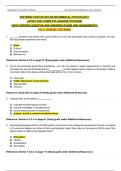Exam (elaborations)
TESTBANK FOR IOP1503 ENVIRONMENTAL PSYCHOLOGY. LATEST 2024 COMPLETE GENUINE TESTBANK (WITH VERIFIED QUESTION AND ANSWERS EXAMS AND ASSINGMENTS) 100 % VERIFIED TESTBANK
- Institution
- University Of South Africa
TESTBANK FOR IOP1503 ENVIRONMENTAL PSYCHOLOGY. LATEST 2024 COMPLETE GENUINE TESTBANK (WITH VERIFIED QUESTION AND ANSWERS EXAMS AND ASSINGMENTS) 100 % VERIFIED TESTBANK
[Show more]



